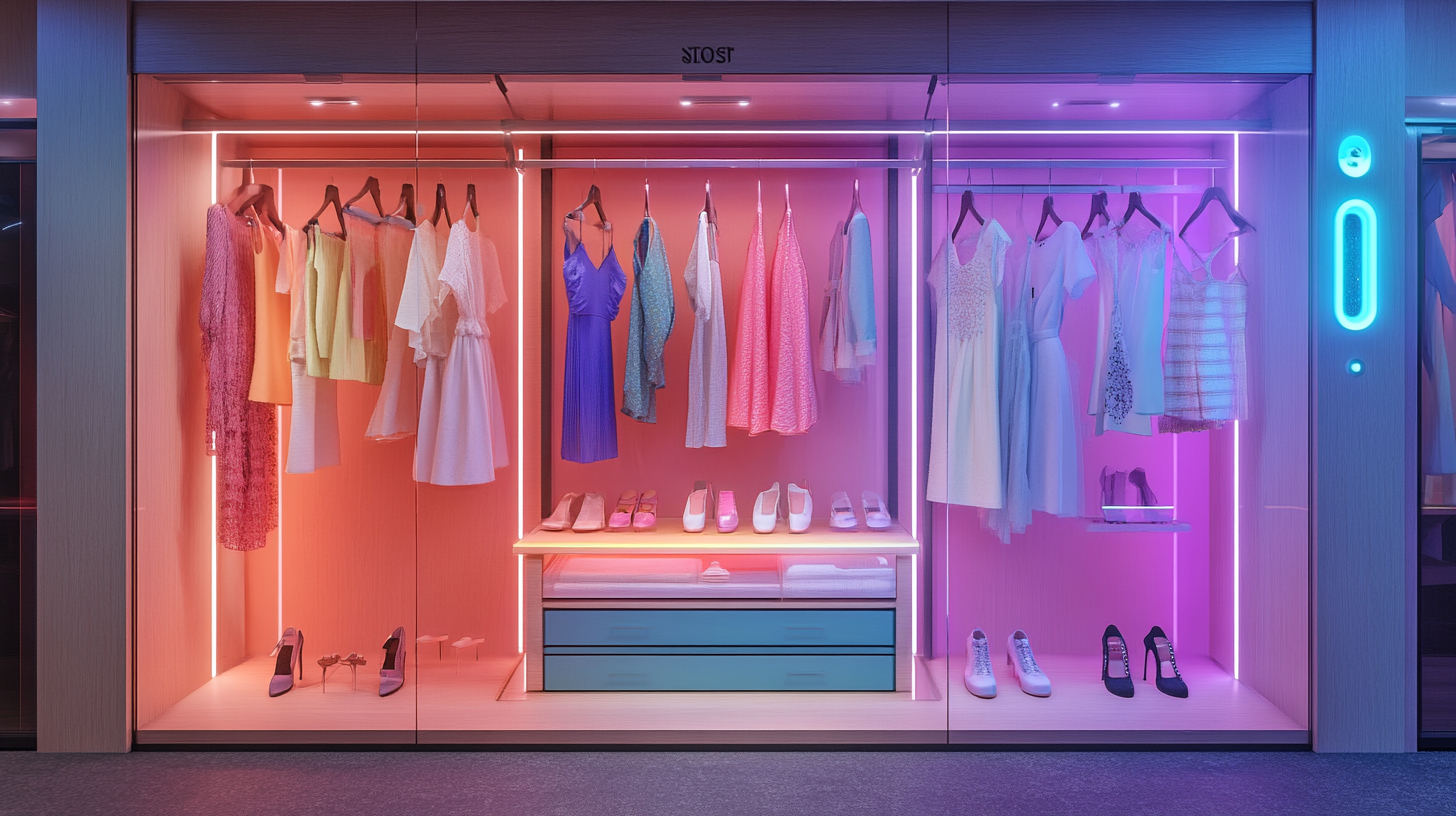Design Your Dream Wardrobe Using AI Fashion Assistants
The fashion industry is undergoing a significant transformation. AI is projected to drive growth to $4.4 billion by 2027, mainly in response to the so-called retail apocalypse that has pushed businesses to adopt innovative technologies.
As e-commerce continues to evolve, AI-powered shopping assistants are emerging as a key solution to enhance the customer experience, offering personalized, on-demand styling advice.
Imagine opening your closet to find a perfectly curated selection of clothes, each piece matched to your style and tailored to the season, occasion, and your preferences. Thanks to advances in AI, this vision is becoming a reality. With rapidly shifting fashion trends and personal styles, AI is making it easier than ever to easily manage your wardrobe.
How to Start Designing Your Dream Wardrobe
Now that you know how AI fashion assistants work, here’s a step-by-step guide to using one to design your dream wardrobe.
1. Assess Your Current Wardrobe
Before introducing AI into the mix, take stock of what you currently own. This could involve manually cataloging your wardrobe or using a tool that allows you to upload images of your clothes. This step is crucial for understanding the gaps in your wardrobe and where AI recommendations could help.
2. Set Style Goals
Are you aiming for a minimalist approach, or are you trying to align your style with current trends? Defining your goals will help the AI fashion assistant tailor recommendations to your specific needs.
3. Choose Your AI Assistant
Pick an AI fashion assistant based on what you want. If you’re looking for personalized shopping suggestions, or if you want help organizing your wardrobe, look for apps that emphasize virtual wardrobe management. Your AI assistant can help optimize your experience with these tasks.
4. Leverage AI for Trend Analysis
AI excels at predicting fashion trends by analyzing data from social media and runways. You can use this real-time trend tracking to incorporate fresh, popular looks into your wardrobe and stay fashion-forward.
5. Input Data and Start Using It
Once you’ve chosen a platform, start feeding it data. The more data you provide, such as clothing preferences, dislikes, event types, and personal style, the better AI can tailor recommendations. Make sure to use the assistant regularly, providing feedback when necessary so it can continue learning from your behavior.

6. Create a Digital Style Portfolio
Save AI-generated outfits and build a digital portfolio of your favorite looks. This helps you track your style preferences and serves as a valuable resource for refining your personal aesthetic or showcasing your styling ideas to others.
7. Experiment with AI-Generated Looks
Let AI inspire your fashion experiments by generating outfits based on specific themes like "minimalist” or "boho chic.” These suggestions can help expand your style horizons and inspire creative combinations from your existing wardrobe.
8. Monitor and Adjust
AI fashion assistants work best when they are continuously learning from your habits. Over time, make sure to update the system with any new clothing purchases, returns, or changes in your style. Regular interaction ensures the AI stays aligned with your evolving preferences.
Tools to Use to Transform Your Magical Closet
You can look up these tools as your AI fashion assistant for a smooth and hassle free experience.
1. Stitch Fix
This is an AI-driven personal styling service that combines data science and human expertise to deliver curated clothing and accessory selections tailored to each user’s style preferences. By filling out a detailed style profile, users enable Stitch Fix to recommend items from a wide variety of brands and styles.
It uses algorithms and machine learning to analyze body type, fashion preferences, and lifestyle habits. Then it pairs that data with insights from human stylists to create a personalized "Fix" delivered directly to the user's door.
Key Features
1. Personalized Styling Services
Stitch Fix uses AI to generate personalized recommendations based on your style profile, including preferences on fit, colors, budget, and lifestyle needs. These recommendations are then reviewed by a human stylist to ensure the final selection meets your tastes.
2. Home Try-On Model
Instead of shopping online, Stitch Fix sends you a curated box of clothing and accessories that you can try on at home. You only pay for what you decide to keep and can return the rest with free shipping.
3. Detailed Style Quiz
The platform asks in-depth questions about your clothing preferences, such as desired cuts, patterns, and colors, to help the AI build a more precise understanding of your style.
Pricing
Stitch Fix charges a $20 styling fee per Fix, which is credited toward any items you choose to keep. Item prices range from $32 to $500 depending on your set budget and preferences.
Pros
- Personalized Selection: It combines AI and human expertise for tailored recommendations.
- Convenient Try-On Process: You don’t need to visit stores, you can try items at home.
- Free Shipping and Returns: The platform has an easy return process for items you don’t want.
Cons
- Styling Fee: There is a non-refundable $20 styling fee if no items are purchased.
- Limited Control: Users have less control over the specific items sent, relying heavily on the algorithm and stylist.

2. Cladwell
This is a wardrobe management and styling app designed to help users make the most out of the clothing they already own. Unlike other fashion apps that push new purchases, Cladwell focuses on sustainability by encouraging users to maximize their current wardrobe.
By uploading photos of your clothes and cataloging your collection, Cladwell’s AI provides daily outfit suggestions based on weather, occasion, and personal preferences.
Key Features
1. Wardrobe Inventory System
Cladwell allows users to upload images of their existing wardrobe and categorize items by type, color, season, and more. This helps users keep track of what they own and avoid duplicate purchases.
2. Daily Outfit Suggestions
Based on your uploaded wardrobe, the app suggests daily outfits using AI that factors in the current weather, your style preferences, and upcoming events. This eliminates the guesswork in dressing each day.
3. Outfit Tracking and Analytics
Cladwell tracks how often you wear each item, helping you analyze wardrobe usage and identify pieces you wear most frequently or items that rarely get used.
Pricing
Cladwell offers a free 7-day trial, after which users can subscribe to the service for $7.99 per month. The annual subscription costs $59.99.
Pros
- Promotes Sustainability: It helps users focus on reusing and restyling existing clothing.
- Custom Outfit Suggestions: AI generates daily outfit recommendations based on personal wardrobe.
- Wardrobe Tracking: The tool provides analytics on how often you wear items, helping optimize wardrobe usage.
Cons
- No Shopping Features: Unlike other fashion assistants, Cladwell does not provide shopping or purchasing recommendations.
- Manual Inventory Upload: Users must manually photograph and upload items into the app, which can be time-consuming.
Success Stories of AI Shopping Assistants in Action
H&M Integrating AI-Powered Virtual Stylist
The famous retail company H&M integrated a virtual assistant and live chat feature into its online shopping experience in 2020 through Google services. This enhanced customer support and streamlined the shopping process. This AI-powered virtual assistant can help customers provide personalized style recommendations based on their preferences.
By integrating Google Cloud's Dialogflow and other AI tools, H&M aims to offer more efficient and interactive customer service, making online shopping smoother and more convenient. The addition of these virtual assistant capabilities reflects H&M’s push to improve digital engagement and optimize customer experience in the increasingly competitive e-commerce space.
North Face Introducing AI-Powered Digital Personal Shopper with IBM Watson
Outdoor apparel brand North Face developed a digital personal shopper using IBM Watson’s AI technology. This virtual assistant engages with customers in real-time, offering personalized product recommendations based on individual preferences and requirements. It even asks follow-up questions to refine its suggestions better.
The Benefits of AI for Fashion and Sustainability
Here, we will explore how AI fashion assistants can contribute to more sustainable fashion choices and help you make the most of your wardrobe.
- Reducing Overconsumption: AI fashion assistants help reduce overconsumption by optimizing your wardrobe and suggesting smarter, more intentional purchases. This cuts down on buying unnecessary items.
- Maximizing Wardrobe Use: AI offers new ways to style existing pieces, helping you get more value out of your current wardrobe and reducing the need for constant new purchases.
- Reducing Fashion Waste: By promoting thoughtful purchasing and styling, AI helps minimize waste, supporting more sustainable fashion choices.
- Promoting Thoughtful Shopping: AI recommends clothing that complements what you already own, encouraging mindful shopping and preventing impulsive buys.
Final Word
Designing your dream wardrobe no longer has to be time-consuming or overwhelming. AI fashion assistants offer a smart, efficient, and personalized approach to wardrobe management, helping you stay stylish while being budget-conscious and eco-friendly. Whether you're looking for daily outfit inspiration or long-term wardrobe planning, AI is transforming the way we dress ourselves.





